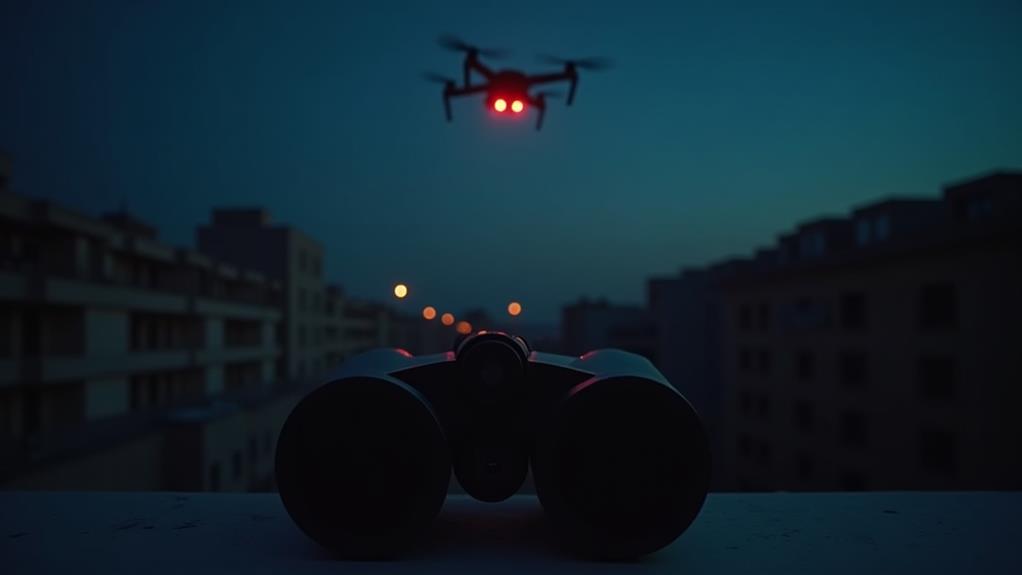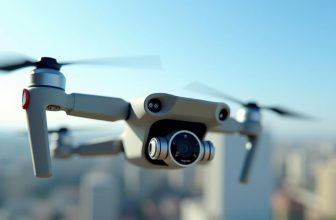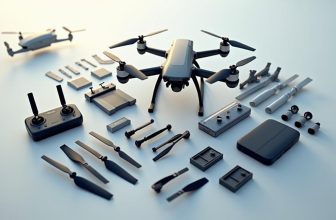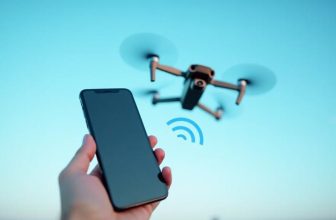
As the veil of darkness falls, a silent intruder may be lurking in the shadows – an unmanned aerial vehicle, or drone, operating under the cover of night. You might be wondering how to detect these elusive flyers when they're most difficult to spot. Utilizing a combination of visual, acoustic, and technological approaches is key to identifying a drone at night. But what specific techniques will give you the upper hand in this cat-and-mouse game? Exploring the various methods, from visual identification to thermal imaging, will reveal the strategies you need to stay one step ahead of these nocturnal visitors.
Contents
- 1 Key Takeaways
- 2 Visual Identification Techniques
- 3 Sound Wave Patterns Analysis
- 4 Radio Frequency Interference
- 5 Drone Light Patterns
- 6 Thermal Imaging Detection
- 7 Acoustic Sensors Use
- 8 Radar System Deployment
- 9 Motion Detection Systems
- 10 Drone Propeller Noise
- 11 Night Vision Goggles
- 12 Frequently Asked Questions
- 13 Conclusion
Key Takeaways
- Use night vision goggles or binoculars to amplify available light and enhance vision for visual detection.
- Utilize acoustic sensors to detect distinct sounds generated by drone propellers and motors.
- Monitor radio frequencies commonly used by drones, such as 2.4 GHz or 5.8 GHz, for distinct signals.
- Employ thermal imaging cameras to capture heat signatures in low-light environments and detect drones.
- Combine multiple detection methods, such as visual, acoustic, and thermal, for a multi-layered detection system.
Visual Identification Techniques
Detecting a Drone at Night
Visual Identification Techniques
When visually identifying a drone at night, you're relying on the limited visual cues available. This is because artificial lighting on the drone is often minimal to avoid detection.
In these situations, you need to maximize your chances of spotting the drone by using available natural light sources.
Starlight observation can be effective in detecting drones flying at high altitudes. However, this method is limited to clear nights with minimal cloud cover.
On nights with moonlight, look for a Moonlit silhouette of the drone against the sky. This can help you identify the drone's shape and size.
To improve your chances of visually identifying a drone, use binoculars or a night vision device to enhance your vision.
Be aware of the drone's potential flight patterns and usual operating altitudes.
By combining these techniques, you can increase your chances of detecting a drone at night.
Remember to stay alert and focused, as visually identifying a drone in low-light conditions requires concentration and attention to detail.
Sound Wave Patterns Analysis
When analyzing sound wave patterns to detect a drone at night, you'll focus on identifying distinct acoustic signals that distinguish drones from other noise sources.
This involves examining the unique noise patterns generated by a drone's rotors, motors, and other mechanical components.
Acoustic Signal Identification
A dozen or so sound wave patterns can help identify a drone at night through acoustic signal identification.
You'll need to analyze sound waves and noise patterns to determine if a drone is present. Sound waves from drones typically fall within the 20 Hz to 20 kHz frequency range, which is within human hearing.
When a drone is flying, it produces a distinct noise pattern characterized by a series of pulses or tones.
Noise Pattern Analysis
Sound wave patterns from drones, as discussed in acoustic signal identification, serve as the foundation for noise pattern analysis.
This process involves analyzing the unique audio signatures emitted by drones to determine their presence and type.
By applying noise pattern analysis techniques, you can identify and differentiate drone signals from other environmental noises.
To start, you'll need to conduct audio profiling, which involves collecting and analyzing audio data from various drone types.
This data is then used to create a library of known drone sound patterns, making it easier to identify unknown signals.
Frequency sampling is a vital aspect of noise pattern analysis, as it allows you to break down complex audio signals into their component frequencies.
Radio Frequency Interference
When analyzing radio frequency interference (RFI) to detect a drone at night, you're looking for specific signals that indicate the drone's presence.
You'll need to identify the drone's signal patterns, which can be achieved by monitoring the radio frequencies commonly used by drones, such as 2.4 GHz or 5.8 GHz.
Drone Signal Identification
Through radio frequency interference (RFI), drones emit distinct signals that can be identified at night.
You can detect these signals by analyzing the radio frequency (RF) spectrum. Drones typically operate on specific frequency bands, such as 2.4 GHz or 5.8 GHz.
By monitoring these frequency bands, you can identify the signal strength and patterns emitted by the drone.
Drone signals often exhibit characteristics like frequency hopping, where the signal rapidly switches between different frequencies within a specific band.
This technique is used to minimize interference and guarantee reliable communication between the drone and its controller.
By identifying the frequency hopping pattern, you can determine the type of drone and its likely location.
You can use specialized equipment, such as spectrum analyzers or RF receivers, to detect and analyze the drone signals.
These tools can provide detailed information about the signal strength, frequency, and modulation scheme used by the drone.
Interference Detection Methods
Detecting a Drone at Night
==========================
Interference Detection Methods
—————————–
Identifying a drone's signal is just the first step in detection.
Once you've pinpointed the signal, you need to analyze the interference it's generating to confirm its presence.
Interference detection methods involve monitoring the radio frequency (RF) spectrum for anomalies that could indicate a drone is nearby.
To detect a drone at night using RF interference, you'll need to focus on the following key aspects:
- *Signal strength*: Measure the signal strength of the detected signal to determine if it's strong enough to be coming from a nearby drone.
- *Frequency analysis*: Perform frequency analysis on the signal to identify the type of frequency being used and whether it matches that of a typical drone signal.
- *Spectral density*: Analyze the spectral density of the signal to identify any patterns or anomalies that could indicate the presence of a drone.
Drone Light Patterns
You're more likely to spot a drone at night by observing its light patterns than by its shape or size.
This is because drones often have distinct light sequences that can be used for identification. Many drones use beacon flashes, which are periodic flashes of light used for navigation and visibility. These beacon flashes can be used to detect and track drones.
When observing a drone's light pattern, look for repetitive sequences of flashes. Some drones use a single color, such as red or white, while others use multiple colors or patterns.
The frequency and duration of the flashes can also be used to identify the drone. For example, a drone may flash its lights three times in rapid succession, followed by a brief pause. By recognizing these patterns, you can increase your chances of detecting a drone at night.
Thermal Imaging Detection
When using thermal imaging detection to identify drones at night, you'll need to weigh the type of thermal camera equipment that can effectively capture heat signatures in low-light environments.
This equipment typically includes high-sensitivity thermal cameras with advanced optics and sensors.
You'll also need to apply image processing techniques to enhance and analyze the thermal images, which can help distinguish drone signatures from background noise.
Thermal Camera Equipment
Frequently, thermal camera equipment proves instrumental in identifying drones at night, as it can detect the heat signatures emitted by these aerial vehicles.
This equipment can be used in various settings, including law enforcement, border patrol, and private security.
Thermal camera equipment, such as thermal scopes, can be used to detect and track drones in low-light environments.
These scopes use heat mapping technology to create images based on the temperature differences in the environment.
This allows you to detect the heat signatures of drones, even if they aren't visible to the naked eye.
Some key features of thermal camera equipment include:
- *High-resolution imaging*: Thermal cameras can produce high-resolution images, allowing you to detect drones at a distance.
- *Low-light sensitivity*: Thermal cameras can detect heat signatures in low-light environments, making them ideal for nighttime drone detection.
- *Real-time video*: Thermal cameras can provide real-time video, allowing you to track drones as they move.
Image Processing Techniques
Thermal imaging detection relies heavily on image processing techniques to accurately identify drones at night.
You'll need to use advanced algorithms to process the thermal images captured by your equipment. One of the key techniques used is object detection, which involves identifying and isolating the drone's heat signature from the surrounding environment.
To enhance the object detection process, you can apply edge enhancement techniques to the thermal images. This involves amplifying the contrast between the drone's heat signature and the background, making it easier to detect the drone.
Edge enhancement can be achieved through various methods, including gradient operators and histogram equalization.
You'll also need to weigh the importance of noise reduction and image filtering techniques to minimize false positives and improve the overall accuracy of the detection system.
By applying these image processing techniques, you can markedly improve the effectiveness of your thermal imaging detection system and increase the chances of detecting a drone at night.
Effective image processing is critical to the success of thermal imaging detection, and you should carefully evaluate and optimize your algorithms to achieve the best results.
Acoustic Sensors Use
Acoustic sensors offer a feasible approach to detecting drones at night, as they can pick up the distinct sounds generated by a drone's propellers and motors.
This method is particularly effective in environments with minimal background noise, allowing you to pinpoint the drone's location.
When using acoustic sensors, bear in mind that you must weigh the following factors:
- Sensor placement: Position the sensors in a way that maximizes their ability to capture the drone's acoustic signature, taking into account the terrain and potential noise sources.
- Sensor calibration: Calibrate the sensors to detect the specific frequency range of the drone's propellers and motors, ensuring accurate detection and minimizing false positives.
- Data analysis: Implement sophisticated algorithms to analyze the acoustic data and separate the drone's signature from other sounds, enabling efficient drone tracking.
Radar System Deployment
When acoustic sensors aren't suitable due to high levels of background noise or complex terrain, you can turn to radar systems for detecting drones at night.
Radar systems use radio waves to detect and track objects, making them effective for drone detection in various environments. To deploy a radar system effectively, you'll need to ponder the type of radar technology that suits your needs.
There are several types of radar systems, including pulse Doppler radar, phased array radar, and frequency-modulated continuous-wave (FMCW) radar.
Before deploying a radar system, vital calibration is necessary to guarantee accurate detection and tracking. Radar calibration involves adjusting the system to account for environmental factors, such as temperature and humidity.
Regular radar maintenance is also pivotal to maintain the system's performance and accuracy. This includes checking for software updates, inspecting the antenna and transmitter, and performing functional tests.
Motion Detection Systems
Motion detection systems offer a vital layer of protection against nighttime drone intrusions, utilizing passive infrared (PIR) sensors or video analytics to pinpoint unusual movements.
These systems work by detecting changes in the thermal signature or pixel pattern within a monitored area, triggering an alert when a drone is detected.
When implementing motion detection systems for dark detection, consider the following key factors:
- Sensor placement: Strategically place PIR sensors or cameras to maximize coverage and minimize blind spots, ensuring that the area of interest is fully protected.
- Motion triggers: Configure motion triggers to account for various drone sizes and speeds, reducing false positives and ensuring accurate detection.
- Integration with other systems: Integrate motion detection systems with radar, acoustic, or other detection methods to create a multi-layered defense against nighttime drone intrusions.
Drone Propeller Noise
A single drone propeller can produce a distinct noise signature, making it a viable target for detection at night.
As you analyze the propeller noise, consider the propeller design, which substantially affects the noise frequency. Typically, a higher propeller pitch and a faster rotation speed produce higher frequency sounds.
Conversely, a lower propeller pitch and slower rotation speed produce lower frequency sounds.
When detecting drones at night, you should focus on the frequency range of the propeller noise. Most commercial drones have propellers that produce noise in the audible frequency range of 20 Hz to 20,000 Hz.
Within this range, you can identify specific patterns and characteristics of the propeller noise. You can use acoustic sensors to capture and analyze the noise signature, allowing you to differentiate between various drone types and models.
Night Vision Goggles
Detecting drones at night is greatly facilitated by the use of night vision goggles, which amplify available light, allowing you to visualize the drone's presence.
These goggles use an image intensification (I2) tube to convert photons into electrons, amplifying available light. This enables you to see objects that would otherwise be invisible in low-light conditions.
When using night vision goggles to detect drones, consider the following factors:
- Night vision limitations: Night vision goggles have limited range and resolution, making it difficult to detect drones at long distances.
- They also have a limited field of view, requiring you to move your head to scan the surroundings.
- Image intensification technology can be affected by weather conditions, such as heavy rain, fog, or moonlight glare.
- Goggle maintenance is vital to guarantee peak performance, as a damaged or dirty objective lens can reduce the goggle's sensitivity.
Regular maintenance, including cleaning the objective lens and replacing batteries, is essential to guarantee your night vision goggles function correctly.
Frequently Asked Questions
Can Pets Detect Drones at Night More Effectively?
You might notice your pet's heightened sensitivity to nocturnal sounds, suggesting their instincts can detect unusual aerial activity, like drones, more effectively at night due to their acute nocturnal hearing capabilities.
Is It Legal to Shoot Down a Drone at Night?
You might think you can take matters into your own hands, but it's generally not legal to shoot down a drone at night. Familiarize yourself with drone laws and respect legal boundaries to avoid potential liability.
Can Drones Be Detected Through Window Glass?
You can detect objects through window glass using sensors, but glass reflections may interfere. Window sensors, like acoustic or seismic detectors, can potentially identify drones, though their effectiveness depends on the drone's noise and vibrations.
Are There Drone-Detecting Apps for Smartphones?
Imagine a hawk scanning the skies, symbolizing your quest for detection. You're in luck, as drone-detecting apps like Drone Radar and Air Scout utilize your smartphone's sensors to detect nearby drones, enhancing your surveillance capabilities.
Can I Use Multiple Detection Methods Simultaneously?
You can combine multiple methods using sensor fusion, a hybrid approach that integrates acoustic, visual, and radar data. This multi-modal detection increases accuracy and reliability, allowing you to identify potential threats more effectively and efficiently.
Conclusion
You've made it through the crash course on how to detect a drone at night. Congratulations, you're now a certified drone detective. Armed with this knowledge, you'll be the envy of all your friends as you expertly spot those pesky drones lurking in the darkness. But let's be real, with great power comes great responsibility – don't get too carried away, or you'll end up like a conspiracy theorist, spotting drones in every bird and tree.






